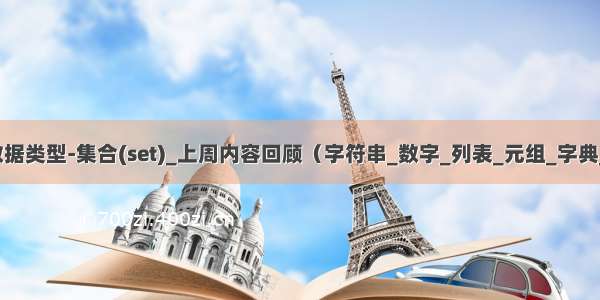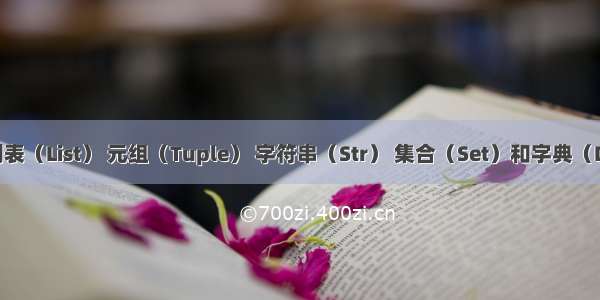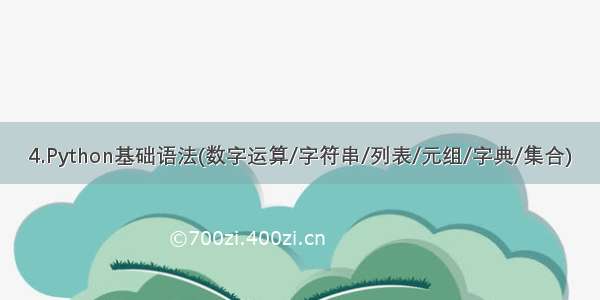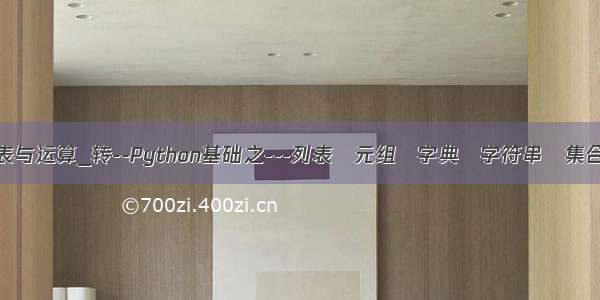
上周内容回顾
1、字符串
2、数字
除了布尔类型外,int、long、float和complex都可以使用的运算为:加、减、乘、除、整除、幂运算和取余
3、列表和元组
列表的内容可变,可以包含任意对象,使用中括号表示。
元组的内容不可变,可以包含任意对象,使用圆括号表示。元组
1 l = [1, 2, 3, '4', '5'] # 列表2 l = list((1, 2, 3, '4', '5'))3 4 t = (1, 2, 3, '4', '5') # 元组5 t = tuple("1234")
1 >>> l = [1, 2, 3, 4, 5]2 >>> del l[1]3 >>> l4 [1, 3, 4, 5]
4、字典
字典(dict)是python为唯一的内置映射类型,任何不可变对象都可以用作字典的键值,如字符串、数字、元组等。字典使用大括号表示,键和值之间用冒号分割,各个键值间用逗号隔开。映射对象是无序的。
1 d = dict((['name', 'wuyuan'], ['age', 23]))2 d = {'name': 'wuyuan', 'blog': '', 'age': 23}3 d['school'] = 'HDU' # 添加一项
字典的历遍方式
1 #使用键历遍2 for i in d:3print i,d[i]4 #使用键值历遍5 for k,v in d.items():6print k,v
5、可变不可变:
1、可变:列表,字典
2、不可变: 字符串,数字,元组
6、访问顺序:
1、直接访问:数字
2、顺序访问:字符串,列表,元组
3、映射: 字典
7、存放元素个数:
容器类型:列表,元组,字典
原子:数字,字符串
详细参考:
一、set集合(可变集合) 集合是一个无序而且不重复的集合,有些类似于数学中的集合,也可以求交集,求并集等
集合特性:
1、不同元素组成
2、无序
3、集合中元素必须是不可变类型
1 class set(object): 2""" 3set() -> new empty set object 4set(iterable) -> new set object 5 6Build an unordered collection of unique elements. 7""" 8def add(self, *args, **kwargs): # real signature unknown 9 """ 10 Add an element to a set,添加元素 11 12 This has no effect if the element is already present. 13 """ 14 pass 15 16def clear(self, *args, **kwargs): # real signature unknown 17 """ Remove all elements from this set. 清除内容""" 18 pass 19 20def copy(self, *args, **kwargs): # real signature unknown 21 """ Return a shallow copy of a set. 浅拷贝 """ 22 pass 23 24def difference(self, *args, **kwargs): # real signature unknown 25 """ 26 Return the difference of two or more sets as a new set. A中存在,B中不存在 27 28 (i.e. all elements that are in this set but not the others.) 29 """ 30 pass 31 32def difference_update(self, *args, **kwargs): # real signature unknown 33 """ Remove all elements of another set from this set. 从当前集合中删除和B中相同的元素""" 34 pass 35 36def discard(self, *args, **kwargs): # real signature unknown 37 """ 38 Remove an element from a set if it is a member. 39 40 If the element is not a member, do nothing. 移除指定元素,不存在不保错 41 """ 42 pass 43 44def intersection(self, *args, **kwargs): # real signature unknown 45 """ 46 Return the intersection of two sets as a new set. 交集 47 48 (i.e. all elements that are in both sets.) 49 """ 50 pass 51 52def intersection_update(self, *args, **kwargs): # real signature unknown 53 """ Update a set with the intersection of itself and another. 取交集并更更新到A中 """ 54 pass 55 56def isdisjoint(self, *args, **kwargs): # real signature unknown 57 """ Return True if two sets have a null intersection. 如果没有交集,返回True,否则返回False""" 58 pass 59 60def issubset(self, *args, **kwargs): # real signature unknown 61 """ Report whether another set contains this set. 是否是子序列""" 62 pass 63 64def issuperset(self, *args, **kwargs): # real signature unknown 65 """ Report whether this set contains another set. 是否是父序列""" 66 pass 67 68def pop(self, *args, **kwargs): # real signature unknown 69 """ 70 Remove and return an arbitrary set element. 71 Raises KeyError if the set is empty. 移除元素 72 """ 73 pass 74 75def remove(self, *args, **kwargs): # real signature unknown 76 """ 77 Remove an element from a set; it must be a member. 78 79 If the element is not a member, raise a KeyError. 移除指定元素,不存在保错 80 """ 81 pass 82 83def symmetric_difference(self, *args, **kwargs): # real signature unknown 84 """ 85 Return the symmetric difference of two sets as a new set. 对称差集 86 87 (i.e. all elements that are in exactly one of the sets.) 88 """ 89 pass 90 91def symmetric_difference_update(self, *args, **kwargs): # real signature unknown 92 """ Update a set with the symmetric difference of itself and another. 对称差集,并更新到a中 """ 93 pass 94 95def union(self, *args, **kwargs): # real signature unknown 96 """ 97 Return the union of sets as a new set. 并集 98 99 (i.e. all elements that are in either set.)100 """101 pass102 103def update(self, *args, **kwargs): # real signature unknown104 """ Update a set with the union of itself and others. 更新 """105 pass
set用法练习
练习一:
1、set输出
1 s=set('hello')2 print(s)
执行结果:
1 {'l', 'e', 'h', 'o'}
2、set去重
ps1:
1 s=set(['alex','alex','sb'])2 print(s)
执行结果:
1 {'sb', 'alex'}
ps2:
1 names=['alex','alex','wupeiqi']2 names=list(set(names))3 print(names)
执行结果:
1 ['alex', 'wupeiqi']
3、add 添加元素 (只能更新一个值)
1 s = {1, 2, 3, 4, 5, 6}2 s.add('s')3 s.add('3')4 s.add(3)5 print(s)
执行结果:
1 {1, 2, 3, 4, 5, 6, 's', '3'}
4、clear 清空元素
1 s = {1, 2, 3, 4, 5, 6}2 s.clear()3 print(s)
执行结果:
1 set()
5、copy 拷贝元素
1 s = {1, 2, 3, 4, 5, 6}2 s1=s.copy()3 print(s)
执行结果:
1 {1, 2, 3, 4, 5, 6}
6、pop随机删
1 s={'sb',1,2,3,4,5,6}2 s.pop()3 print(s)
执行结果:
1 {2, 3, 4, 5, 6, 'sb'}
7、remove discard 指定删除
remove 删除不存在元素,会报错。
discard 删除不存在元素,不会报错。
1 s={'sb',1,2,3,4,5,6}2 s.remove('sb')3 s.remove('hellol')'''集合中不存在这个元素,删除不存在元素会报错'''4 s.discard('sbbbb')'''集合中不存在这个元素,删除不存在元素不会报错'''5 print(s)
执行结果:
1 File "D:/python/day5/集合.py", line 322s.remove('hellol')'''删除元素不存在会报错'''3 ^4 SyntaxError: invalid syntax
二、集合的交集、并集、差集
集合支持一系列标准操作,包括并集、交集、差集和对称差集。
例如:
1 a = t | s# t 和 s的并集 2 3 b = t & s# t 和 s的交集 4 5 c = t – s# 求差集(项在t中,但不在s中) 6 7 d = t ^ s# 对称差集(项在t或s中,但不会同时出现在二者中)
用法示例:
1、intersection求交集(交集:两边都存在相同的内容,就取出来)
1 python_l=['lcg','szw','zjw','lcg']2 linux_l=['lcg','szw','sb']3 p_s=set(python_l)4 l_s=set(linux_l)5 print(p_s,l_s)6 7 #求交集 (交集:两边都存在相同的内容,就取出来)8 print(p_s.intersection(l_s))9 print(p_s&l_s)
执行结果:
1 {'szw', 'zjw', 'lcg'} {'szw', 'sb', 'lcg'}2 {'szw', 'lcg'}3 {'szw', 'lcg'}
2、union求并集(并集:两个集合的元素合到一起)
1 python_l=['lcg','szw','zjw','lcg']2 linux_l=['lcg','szw','sb']3 p_s=set(python_l)4 l_s=set(linux_l)5 print(p_s,l_s)6 print(p_s.union(l_s))7 print(p_s|l_s)
执行结果:
1 {'lcg', 'zjw', 'szw'} {'lcg', 'sb', 'szw'}2 {'lcg', 'szw', 'sb', 'zjw'}3 {'lcg', 'szw', 'sb', 'zjw'}
3、difference 差集 (差集:两个数相减,得出的结果就是差集)
ps1:
1 python_l=['lcg','szw','zjw','lcg'] 2 linux_l=['lcg','szw','sb'] 3 p_s=set(python_l) 4 l_s=set(linux_l) 5 print(p_s,l_s) 6 7 print('差集',p_s-l_s) 8 print(p_s.difference(l_s)) 9 10 print('差集',l_s-p_s)11 print(l_s.difference(p_s))
执行结果:
1 {'zjw', 'szw', 'lcg'} {'sb', 'szw', 'lcg'}2 差集 {'zjw'} #左边减右边,减去左边和右边相同的,得出左边不相同的3 {'zjw'}4 差集 {'sb'} #右边减左边,减去右边和左边相同的,得出右边不相同的5 {'sb'}
ps2: 差集 p_s-l_s
1 python_l=['lcg','szw','zjw','lcg']2 linux_l=['lcg','szw','sb']3 p_s=set(python_l)4 l_s=set(linux_l)5 print(p_s,l_s)6 print('差集',p_s-l_s) #去掉同时报两门课程的人,得出只学一门课程的人
执行结果:
1 {'lcg', 'szw', 'zjw'} {'lcg', 'szw', 'sb'}2 3 差集 {'zjw'} #结果得出只学一门课程的人
4、symmetric_difference交叉补集 (交叉补集:先把两个合在一起,然后去掉两个都有的共同部分)
1 python_l=['lcg','szw','zjw','lcg']2 linux_l=['lcg','szw','sb']3 p_s=set(python_l)4 l_s=set(linux_l)5 print(p_s,l_s)6 print('交叉补集',p_s.symmetric_difference(l_s))7 print('交叉补集',p_s^l_s)
执行结果:
1 {'szw', 'zjw', 'lcg'} {'szw', 'sb', 'lcg'}2 交叉补集 {'sb', 'zjw'}3 交叉补集 {'sb', 'zjw'}
5、差集 difference_update
1 python_l=['lcg','szw','zjw','lcg']2 linux_l=['lcg','szw','sb']3 p_s=set(python_l)4 l_s=set(linux_l)5 print(p_s,l_s)6 # print('差集',p_s-l_s) #去掉同时报两门课程的人,得出只学一门课程的人7 p_s=p_s-l_s
8 p_s=p_s-l_s = p_s.difference_update(l_s)9 print(p_s)
6、isdisjoint 交集 (是否有交集,有的话返回False,没有的话返回True)
1 s1={1,2}2 s2={3,5 #没有相同的就返回True3 #s2={2,3,5} #有相同的就返回False4 print(s1.isdisjoint(s2))
执行结果:
1 True#s2={3.5}2 Flase #s3={2,3,5}
7、issubset (s1<=s2) s1是s2的子集 or s2是s1的父集
issuperset (s1>=s2) 判断一个集合是另一个集合的子集 (s2 是s1 的父集)
1 s1={1,2}2 s2={1,2,3}3 print(s1.issubset(s2)) #s1 是s2 的子集4 print(s2.issubset(s1)) #False5 print(s2.issuperset(s1)) #判断一个集合是另一个集合的子集 (s2 是s1的父集)
执行结果:
1 True2 False3 True
8、update 更新多个值
1 s1={1,2}2 s2={1,2,3}3 # s1.update(s2) #更新多个值
执行结果:
1 {1, 2, 3}
9、frozenset不可变集合元素一经创建,不可增加、删除和修改。因此没有add、pop、discard、remove和所有以_update结尾的方法。但可以作为左值接受赋值。
frozenset和set混合运算时,返回的值以左边的操作变量为准。
ps1:
1 frozenset(a) | set(b) 的返回值就是frozenset,2 3 set(a) | frozenset(b) 的返回值就是set
ps2:
1 s1=frozenset('hello')2 print(s1)
执行结果:
1 frozenset({'l', 'h', 'o', 'e'})
其它练习
1 s1={1,2,3,1}#定义一个set s1 如果s1={}为空则默认定义一个字典 2 s2=set([2,5,6]) #定义一个set s2 3 print(s1) #s1={1,2,3} 自动去除重复的元素 4 5 s1.add(5) #s1={1,2,3,5} 添加一个元素 6 print(s1) 7 8 s3=s1.difference(s2) #返回一个s1中存在而不存在于s2的字典s3,s3={1,3},而s1并没有改变 9 print(s3)10 11 s1.difference_update(s2) #s1跟新成上面的s3 s1={1,3}12 s1.discard(1)#删除元素1,不存在的话不报错 s1={3}13 print(s1)14 s1.remove(3)#删除元素3,不存在的话报错 s1={}15 print(s1)16 s1.update([11,2,3]) #跟新s1中的元素,其实是添加 s1={11,2,3}17 print(s1)18 k=s1.pop() #删除一个元素,并将删除的元素返回给一个变量,无序的,所以并不知道删除谁19 20 21 s1={1,2,3,4}#这里重新定义了集合s1,s222 s2={3,4,5,6}23 r1=s1.intersection(s2) #取交集,并将结果返回给一个新的集合 r1={3,4}24 print(r1)25 print(s1)26 s1.intersection_update(s2) #取交集,并将s1更新为取交集后的结果 s1={3,4}27 print(s1)28 29 k1=s1.issubset(s2) #s1是否是s2的的子序列是的话返回True,否则False 这里k1=true30 print(k1)31 k2=s1.issuperset(s2) #s1是否是s2的父序列 k2=False32 33 k3=s2.isdisjoint(s1) #s1,s2,是否有交集,有的话返回False,没有的话返回True34 print(k3)35 s1.update([1,2]) #s1={1,2,3,4}36 r3=s1.union(s2) #取并集将结果返回给r3 r3={1,2,3,4,5,6}37 print(r3)38 r2=s1.symmetric_difference(s2)#r2=s1并s2-s1交s2 r2={1,2,5,6}39 print(r2)40 s1.symmetric_difference_update(s2)#s1更新为 s1并s2 - s1交s2 s1={1,2,5,6}41 print(s1)
















